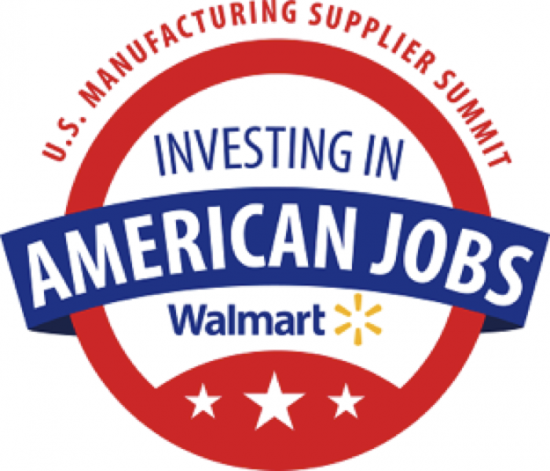There’s no better example of the recent trend of “Made in America” products than this year’s Ralph Lauren’s Olympics uniforms. But Ralph isn’t the only one leading the “Made in America” charge.

Photo Credit: Fortune
Walmart is also capitalizing on the trend. According to them, “Made in the USA” is a strong driver of purchase decisions that is second only to price.
And the research backs it up. Almost 8 in 10 American consumers say they would rather buy an American-made product than an imported one, according to Consumer Reports. Yet manufacturing jobs have been halved since the 1980s when manufacturing accounted for a quarter of all U.S. labor, according to Fortune.
Walmart is taking action. They recently hosted 450 business owners at their headquarters as part of their “Made in the USA” initiative to source an additional $250 billion in products made, assembled, or grown in the US by 2023.

They are investing in the American dream by creating one million new US jobs through this initiative – 250,000 direct manufacturing jobs and 750,000 in support and service sectors.
Out with the cost, in with the jobs.
We know that the primary driver to these decisions will be cost. It’s as simple as driving down costs to keep prices low for customers, and ultimately improving the standard of living in the cities that they have stores.
If manufacturers can drive unnecessary costs out of their processes, they can bring back the jobs.
Here’s one story of how employees saved the day by bringing back production of the swivel-headed owl from China to Knoxville.

In 2013, Walmart said it would buy more owls if Dalen could make them in the United States. Dalen could get a better deal for raw materials with Walmart’s contract, but the cost of US labor was still holding them back.
One Knoxville employee came up with a new tool to make it easier to mount the head, and others were able to speed up the attachment of eyes and beak (the only parts that still come from outside the U.S.)
As a result, Dalen now makes hundreds of thousands more owls with only a couple of additional employees and many Dalen staff now work year-round.
Companies need to disrupt their historical thinking to keep costs low and bring jobs back.
Here are 8 ways innovative strategies to help:
- Deliver quality the first time and every time to improve unnecessary costs
- Make Manufacturing Flexible to be able to “change on the fly” and reduce costly changeover times
- Use analytics to drive smarter machines and optimize uptime for manufacturing and the supply chain
- Predict machine failures with analytics to approach zero unscheduled downtime
- Bridge the skills gap with training to deal with an aging workforce
- Lower energy costs by implementing sustainability programs
- Strengthen security to safeguard against costly breaches
- Optimize the supply chain and logistics to speed time to market
The question is really about strategy and execution. Ask yourselves – are you playing offense or defense?
“Digital is the main reason that half of the Fortune 500 companies have disappeared since the year 2000.” – Pierre Nanterme, CEO of Accenture
Digital strategy in manufacturing is not only a good idea but is fundamentally required to future-proof companies.
The time for “wait and see” is over and the time “for let’s get it done” is now. This may be the first of many opportunities to help drive the manufacturing business back to the USA, and we cannot take this for granted.
As we head into 2017, I have never been more excited to see Cisco’s commitment to the Manufacturing Industry. We are developing technologies and making acquisitions that are all aimed at helping to drive your digital journeys and successes.
We can help you take the next step:

Well thought…I think it’s time to bring back again what it has been outsourced. The USA workforce need to feel again those old days of job security and future expectations.
The wheel can be redesigned to accomplish whatever is needed, to lower production cost and fill every industry’s budget gap. It implies a better planning and expenses’s control.
Certainly can be improved…
Dr. Wong-Perez:
Thanks so much for your words and inspiration and yes let’s find a way to make it happen! The key is these companies are not coming back the same way they left. The need to drive down the operational costs and become world class with both their operations and financial systems. The technology evolution (or more like revolution!) is happening at an incredible pace, and companies need to take advantage of the solutions that can impact their business challenges regardless of where they are on their journey.
It is a very exciting time and we are all in to help!
Thanks again and really appreciate your comments
Steve
Great article, makes me excited to be a catalyst to help US manufacturer’s make technology investments that will make them competitive when on US soil and positively impact the US economy as a whole. Go USA!
Go USA is right!
Sometimes we need a paradigm shift or a catalyst to create the opportunity to change, and this is our time! What it took to get us here may not be enough to keep us here in this opportunity to drive manufacturing back to the USA. Complacency is not an option and let’s all find a way to work together to drive value across the entire manufacturing journey from farm to fork!!
Thanks for the insight and enthusiasm!!
great insight.
Innovation strategies will be relevant to more companies across the globe shifting their manufacturing strategies from outsourcing overseas to developing products closer to where they will be sold. Other factor to consider is, increase in manufacturing sector will positively affect the growth rate of services sector as well.
Nitin:
Great comments for sure! The pull through and “domino effect” that this can have across every aspect of manufacturing like services, supply chain, and overall customer experiences could be incredible!
Thanks for taking time to comment, and really appreciate hearing form you!
Steve
We need to eliminate the stigma of attending a technical college over a brick and mortar four year school. Kids are still being told they have to go to college, and criticized if they choose to enter a technical college to learn a trade. I worked at one for over 15 years and have seen the impact of parental do gooders vicariously living their life and compensating for their own failures. President Obama has made many efforts to highlight the value of our technical schools, but there is still a lot of work to do. My own son has chosen to attend our local technical school. He will have the option of 147 different programs, many of them provide a pathway of direct transfer to our world class university system for the four year degree if that is the end game.
Peter:
I couldn’t agree more! IN fact we had these conversations with both of our kids to put their future in their own hands, and not int he hands of a four year degree expectation. We were willing to support them regardless of their choice and I think that the technical schools are an absolutely excellent option as everyone makes their choices. We NEED this future generation to drive manufacturing from the ground up and the skills of a machine operator or a logistics manager can have a significant impact on the health (and longevity) of a company.
Thanks for your comments…really appreciate it!
Steve
Encouraging to read. Let’s keep more manufacturing in the USA!
From the team at Aegis Power Systems, a power supply manufacturer in NC.
Aegis Power team:
Thanks for the comments and let’s all work together to help create the opportunities, and help our customers achieve their results they need in order to future proof themselves in this very dynamic market. I have a feeling that Walmart is only the beginning and we will see this trend continue.
Thanks for the comments!!
Steve